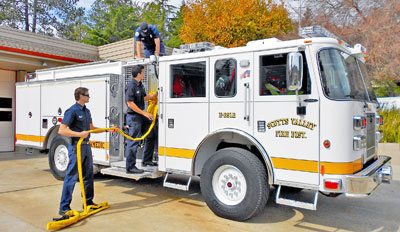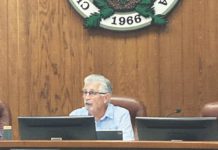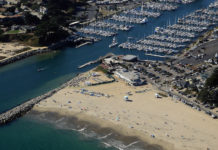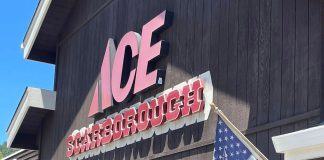
A new set of wheels recently showed up at the Scotts Valley Fire Protection District, as the department took delivery of a brand-new Type-1 fire engine.
Custom-built by Appleton, Wis.-based Pierce Manufacturing, Engine No. 2512 was delivered in time for the start of the New Year.
No. 2512 is the district’s first new engine since 2006. The engine it replaced — purchased in 2001 — will become a reserve.
“We try and stagger it,” said Battalion Chief Jim Delucchi. “When we take one out of service, we have one to replace it.”
Delucchi said that the new engine’s sticker price had been about $525,000, but the district was able to negotiate it down to $452,000 thanks in part to its longstanding business relationship with Pierce Manufacturing.
Engine No. 2512 joins the Scotts Valley fleet of three other Type-1 engines and one Type-3 engine.
A Type 1 engine is designed for use in urban landscapes where fire hydrants are easily available, while Type-3 engines are mainly used for wildfires.
The 1,250-gallons-per-minute pumping capacity of the Type-1 dwarfs that of the 500-gallons-per-minute capacity Type-3.
Engineer/paramedic Andy Sundermier said a wildfire engine has to pump at a slower rate, because sometimes all the water firefighters have in rural situations is in the 500-gallon tank attached to the engine.
While No. 2512 looks no than the district’s three other Type 1 engines, there are several new features and modifications installed that make the new engine stand apart.
“The major difference is engine size,” Sundermier said.
No. 2512 features a 400-horsepower engine, an improvement over the 330 horsepower generated by its predecessors.
“It makes much better time on Highway 17,” he said.
Other special features include lowered storage compartments that make hoses, ladders, and other rescue equipment more accessible to firefighters.
According to Delucchi, who celebrated 30 years with the department this year, the entire rear of the engine was lifted six inches to grant greater clearance and help the engine handle the steep driveways and other geographical hazards in the area.
“These things are battleships — steel and rubber,” he said, pointing to the large engine. “Scotts Valley is not flat.”
In addition to the greater clearance, Delucchi said, all of the district’s Type 1 engines feature “coordinated” and “crab” steering settings that allow the large engines to make sharp turns and maneuvers.
In coordinated mode, the rear wheels turn in the opposite direction of the front, allowing the engine to perform extremely sharp turns at speeds up to 35 mph.
In crab mode, both sets of wheels turn in the same direction, allowing the engine to move forward in a diagonal angle.
Sundermier said No. 2512 also features an all-LED light system, which allows for less strain on the engine’s electrical generator, as well as a digitized water pressure gauge.
To comment, email reporter Joe Shreve at jo*@*********er.com, call 438-2500 or post a comment at www.pressbanner.com.











